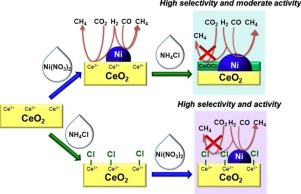当前位置:
X-MOL 学术
›
Appl. Catal. B Environ. Energy
›
论文详情
Our official English website, www.x-mol.net, welcomes your
feedback! (Note: you will need to create a separate account there.)
The insights into chlorine doping effect on performance of ceria supported nickel catalysts for selective CO methanation
Applied Catalysis B: Environment and Energy ( IF 20.2 ) Pub Date : 2017-09-20 , DOI: 10.1016/j.apcatb.2017.09.038 M.V. Konishcheva , D.I. Potemkin , P.V. Snytnikov , O.A. Stonkus , V.D. Belyaev , V.A. Sobyanin
Applied Catalysis B: Environment and Energy ( IF 20.2 ) Pub Date : 2017-09-20 , DOI: 10.1016/j.apcatb.2017.09.038 M.V. Konishcheva , D.I. Potemkin , P.V. Snytnikov , O.A. Stonkus , V.D. Belyaev , V.A. Sobyanin

|
Selective CO methanation (CO-SMET) in the reformate gas, containing (vol.%): 1.0 CO, 65 H2, 10 H2O, 20 CO2 with He as balance, was investigated over a number of nickel-ceria catalysts: treated with NH4Cl before (Ni/CeO2(Cl*)) and after (Ni(Cl*)/CeO2) Ni deposition, prepared by Cl-containing Ni precursor (Ni(Cl)/CeO2) and Cl-free one (Ni/CeO2). The effect of residual chlorine, originating from the catalyst preparation procedures, on the activity and CO selectivity of the samples was demonstrated. It was shown that all Cl-containing Ni/CeO2 catalysts provided efficient CO cleanup. They provided the removal of CO from reformate gas to the level below 10 ppm with a selectivity up to 90%. The catalyst characterization by BET, XRD, XPS, HAADF-STEM, EDX-mapping, FTIR in situ and CO chemisorption techniques revealed that the decrease in chlorine content in the order Ni(Cl)/CeO2 ≥ Ni(Cl*)/CeO2 > Ni/CeO2(Cl*) was accompanied by the increase of Ni dispersion that most likely provided high performance of Ni/CeO2(Cl*) in CO-SMET. The turnover frequencies of Ni surface atoms as well as activation energies in CO methanation were practically similar for all studied catalysts, indicating that Cl did not influence catalyst’s activity and CO methanation proceeded by similar ways over Ni surface in both Cl-free and Cl-containing samples. The advanced performance of Cl-containing catalysts was associated with the inhibition of undesirable side reaction of CO2 methanation. The chlorine doping effect was attributed to the blockage of surface Ce3+-coupled oxygen vacancy sites by CeOCl species that inhibited ceria-assisted CO2 activation and hydrogenation. The CeO2 treatment with NH4Cl before Ni deposition allows to prepare highly active and selective CO-SMET catalyst with high nickel dispersion and Cl-modified ceria surface.
中文翻译:

氯掺杂对二氧化铈负载的镍催化剂选择性CO甲烷化性能的影响的见解
选择性CO甲烷化(CO-SMET)的重整气中,含有(体积%):1.0 CO,65小时2,10 H 2 O,20 CO 2与He作为平衡,进行了调查在多个镍-氧化铈的催化剂的:在(Ni / CeO 2(Cl *))之前和(Ni(Cl *)/ CeO 2)Ni沉积后用NH 4 Cl处理,由含Cl的Ni前驱物(Ni(Cl)/ CeO 2)和Cl制备-一种(Ni / CeO 2)。证明了源自催化剂制备步骤的残留氯对样品活性和CO选择性的影响。结果表明,所有含Cl的Ni / CeO 2催化剂可有效净化一氧化碳。他们提供了从重整产品气体中去除CO的水平,使其含量低于10 ppm,选择性高达90%。通过BET催化剂表征,XRD,XPS,HAADF-STEM,EDX-映射,FTIR原位和CO化学吸附技术时发现,该顺序的Ni(CL)的降低在氯含量/的CeO 2 ≥镍(CL *)/的CeO 2 > Ni / CeO 2(Cl *)伴随着Ni分散度的增加,最有可能提供Ni / CeO 2的高性能(Cl *)在CO-SMET中。对于所有研究的催化剂,Ni表面原子的转换频率以及活化能在CO甲烷化中实际上是相似的,这表明Cl不会影响催化剂的活性,并且在无Cl和含Cl的情况下,Cl均以相似的方式在Ni表面上进行了CO甲烷化。样品。含氯催化剂的先进性能与抑制不希望的CO 2甲烷化副反应有关。氯的掺杂作用归因于CeOCl物种对Ce 3+偶联的氧空位位点的阻塞,从而抑制了二氧化铈辅助的CO 2活化和氢化。NH 4的CeO 2处理在镍沉积之前使用Cl可以制备具有高镍分散度和Cl改性二氧化铈表面的高活性和选择性CO-SMET催化剂。
更新日期:2017-09-20
中文翻译:

氯掺杂对二氧化铈负载的镍催化剂选择性CO甲烷化性能的影响的见解
选择性CO甲烷化(CO-SMET)的重整气中,含有(体积%):1.0 CO,65小时2,10 H 2 O,20 CO 2与He作为平衡,进行了调查在多个镍-氧化铈的催化剂的:在(Ni / CeO 2(Cl *))之前和(Ni(Cl *)/ CeO 2)Ni沉积后用NH 4 Cl处理,由含Cl的Ni前驱物(Ni(Cl)/ CeO 2)和Cl制备-一种(Ni / CeO 2)。证明了源自催化剂制备步骤的残留氯对样品活性和CO选择性的影响。结果表明,所有含Cl的Ni / CeO 2催化剂可有效净化一氧化碳。他们提供了从重整产品气体中去除CO的水平,使其含量低于10 ppm,选择性高达90%。通过BET催化剂表征,XRD,XPS,HAADF-STEM,EDX-映射,FTIR原位和CO化学吸附技术时发现,该顺序的Ni(CL)的降低在氯含量/的CeO 2 ≥镍(CL *)/的CeO 2 > Ni / CeO 2(Cl *)伴随着Ni分散度的增加,最有可能提供Ni / CeO 2的高性能(Cl *)在CO-SMET中。对于所有研究的催化剂,Ni表面原子的转换频率以及活化能在CO甲烷化中实际上是相似的,这表明Cl不会影响催化剂的活性,并且在无Cl和含Cl的情况下,Cl均以相似的方式在Ni表面上进行了CO甲烷化。样品。含氯催化剂的先进性能与抑制不希望的CO 2甲烷化副反应有关。氯的掺杂作用归因于CeOCl物种对Ce 3+偶联的氧空位位点的阻塞,从而抑制了二氧化铈辅助的CO 2活化和氢化。NH 4的CeO 2处理在镍沉积之前使用Cl可以制备具有高镍分散度和Cl改性二氧化铈表面的高活性和选择性CO-SMET催化剂。











































 京公网安备 11010802027423号
京公网安备 11010802027423号